by Briscoe White | Feb 24, 2011 | Basics, Containers, Gardening, Growing, Herbs, Indoor Gardening, Inspiration, Miscellaneous, Recipes |
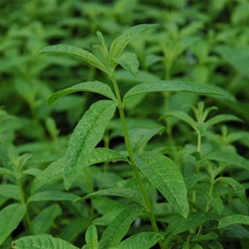
I know I say this with many herbs, but Lemon Verbena has to be one of my absolute favorites. It is easy to grow and maintain, loves living in a pot on the windowsill, and smells delightful! Lemon Verbena has a wonderful lemon flavor with no bitterness– nature’s lemon candy. Try adding a few leaves to your next cup of tea, or steep a few leaves in milk to be used in pudding or ice cream. You could even see if you can find some Lemon Verbena scented wax melts and use deluxe aroma burners to really fill your home with the scent.
Lemon Verbena likes warm, sunny conditions and well-drained soil. If kept warm inside all year, lemon verbena is an evergreen perennial; if exposed to frost, it is deciduous. Do not over-water, and prune in the fall for a bushier plant in the spring.
As previously stated, Lemon Verbena’s lovely medium-green leaves give off a light lemony scent. Before guests arrive I make sure to shake and brush the leaves around a bit, to stimulate the essential oils and really release the natural aroma of my indoor verbenas. Guests love it, especially on cold winter nights when we’re dreaming of summer lemonade and sunshine.. And might I add how much healthier it is to have fresh, all-natural, sweet-smelling herbs and flowers in your house, rather than scented candles and air fresheners? Scented candles are one of the most popular house-hold carcinogens. Plants, on the other hand, detoxify your home!

One common problem associated with Lemon Verbena is spider mites. They love the underside of the leaves. Keep an eye out for these little buggers, and if you do have a problem pick up a mild non-toxic insecticide at your favorite store. You can also companion plant herbs that are natural insecticides, like Rue, Pyrethrum and Tansy nearby to help discourage unwanted pests!
by Herb Exchange | Feb 15, 2011 | Inspiration, Miscellaneous, Recipes |
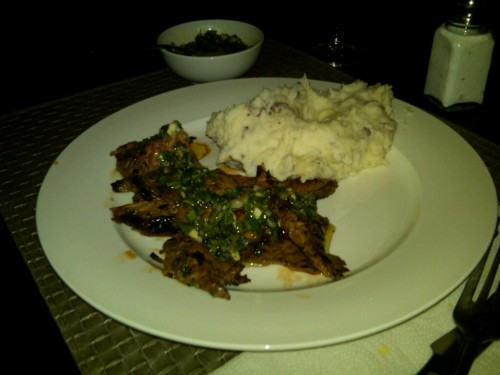
Chimichurri Steak
Our resident Chef and Office Manager, Julie discovered a great recipe over the weekend using fresh herbs. The fresher, the better!
There are so many herbs in our greenhouse to choose from that I can go on a culinary adventure any day of the week. On Friday, I chose to put a little Latin flair into my weekend by whipping up a delicious Argentinean chimichurri sauce with fresh ‘Italian Flat Leaf’ Parsley, ‘English’ Thyme, and ‘Greek’ Oregano that I got right here at The Growers Exchange. This recipe was super simple but packed a world of flavor when drizzled over my perfectly grilled steak!!
Chimichurri (you can use a food processor or chop by hand):
1 1/2 cup Spanish olive oil
Juice of 2 limes
1 1/2 cup finely chopped fresh ‘Italian Flat Leaf’ Parsley
8 cloves garlic, finely chopped
1 shallot, minced
1 Tbsp each finely chopped fresh ‘English’ Thyme and ‘Greek’ Oregano
Salt and pepper to taste
Instructions:
Combine the ingredients in a bowl and season with salt and pepper. Or, place the herbs, shallots and salt & pepper into a food processor. Pulse until fine, then drizzle the olive oil down the shoot while pulsing and until you get your desired texture. Divide the chimichurri between 2 bowls. Use half as the marinade and half as the dipping sauce.
Steak:
2 lb skirt steak
Chimichurri
Salt and pepper
Instructions:
1. Place the steak in a large baking dish and pour half of the chimichurri over it. Turn to coat; cover and marinate in the refrigerator for 2 hours.
2. Preheat grill to high. Let the steak come to room temperature. Remove it from the marinade and season with salt and pepper. Grill for 4 to 5 minutes on one side until browned, turn, and grill another 4 to 5 minutes for medium-rare doneness. Remove from the grill, let the meat rest for 10 minutes, and slice thinly on the bias. Serve with the remaining chimichurri on the side
by Herb Exchange | Jan 27, 2011 | Herbs, Miscellaneous, Recipes |
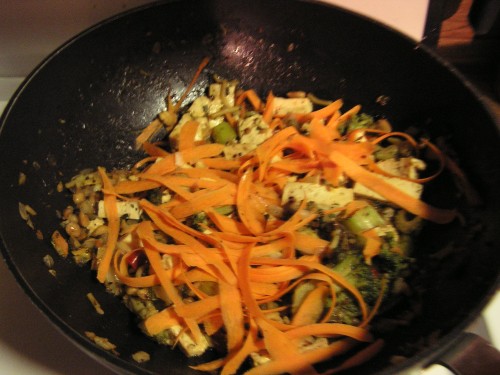
This is an easy recipe for even the worst cook out there! You can add whatever you like, flavor to your desired intensity and best of all, it’s super healthy and cheap to make! Try substituting your protein source if you’re not into tofu…chicken or shrimp will also work well!
Ingredients
- Canola Oil (enough to coat the bottom of the wok)
- 1 Pkg Organic Firm Tofu
- 1 Bag Frozen Vegetables ( I used a stir fry mix that included broccoli, mushrooms, red peppers and rice noodles)
- 3 Spears Fresh Celery
- 1 Carrot, Shaved
- 1/4 Chopped Onion (or add to taste)
- 1 Cup Crushed Peanuts
- Crushed Red Pepper Flakes (to taste)
Marinade
- 1 Cup General Tso Sauce ( I found this prepackaged at the grocery store)
- 1/2 Cup Thai Basil ‘Siam Queen’ (dried from fresh plants)
- 2 Cloves Fresh Garlic
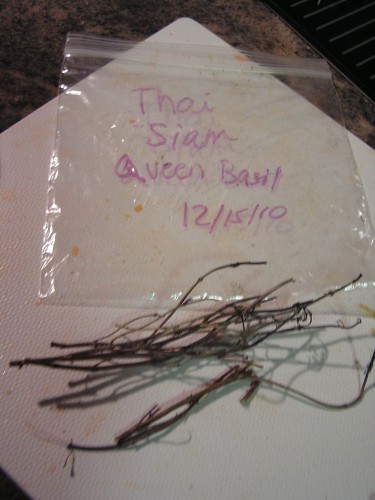
The ‘Siam Queen’ Thai Basil I used was grown right here on our farm at The Growers Exchange! I salvaged one of the plants before it was done for the season and brought it home to experiment with. When I realized that my cats were going to eat it if I didn’t do something with it quickly, I snipped the stems at the soil level and dried the leafy stalks in my warm, dry pantry. (Our of their furry, destructive reach!) After it was dried, I placed it, stems and all, into a labeled zip lock baggie for later used. Removing the dried leaves were easy–just rub the sides of the bag together and they literally crumble from the stems into a perfect dried seasoning. Remove the stems and you have a delicious culinary herb with sweet, licorice and lemon flavored tones.
Don’t be intimidated to use new herbs, as I was at first with this exotic Basil. Being so used to its Italian cousins, like the ‘Italian Large Leaf’ Basil, I was a bit pessimistic when planning my meal, since it was a new flavor. (‘Lemon Sweet Dani’ Basil, another lemon-anise flavored Basil, may also be a great flavor to add to your favorite Asian recipe) Luckily, it turned out GREAT! Try using new culinary herbs in your recipes and you might surprise yourself as to the exciting new flavors you discover!
Instructions
**This works best if your vegetables are either fresh or you have thawed your frozen veggies prior to cooking.
Heat your wok on medium heat and add canola oil til it coats the bottom. While this is heating, slice tofu into even pieces and press excess water out. Add pressed tofu, General Tso sauce, 2 cloves of fresh garlic, and 1/2 of the Basil ‘Siam Queen’ to a bowl and let marinate. Make sure all pieces are coated. (You can also let your protein marinade over night which will make it more flavorful. Because tofu absorbs sauce or seasoning easily, it may not need as long to marinate. For chicken, shrimp or other proteins, they may take long to absorb the desired amount of flavor).
Add a clove of garlic and the chopped onion to the heated canola oil in the wok and let them simmer for a minute to release their flavor. Then, add vegetable mix, chopped celery, crushed peanuts and season with the remaining ‘Siam Queen’ Basil and red pepper flakes. Let this simmer together, remaining on medium to low heat, and stir occasionally. Once mixture seems to be cooked thoroughly and there are no frozen pieces left, add marinated tofu. Stir and let cook for 3-5 minutes or until tofu has cooked through and mixture seems well combined and cooked. (The air in your kitchen should be brimming with aromas by now!) Top with shaved carrot and let simmer for another minute, but remove from heat before carrot is wilted.
Serve and top with more crushed peanut. You can also use an edible, aromatic herb like ‘Citrus Kitchen’ Mint as a great garnish. Eat and enjoy!
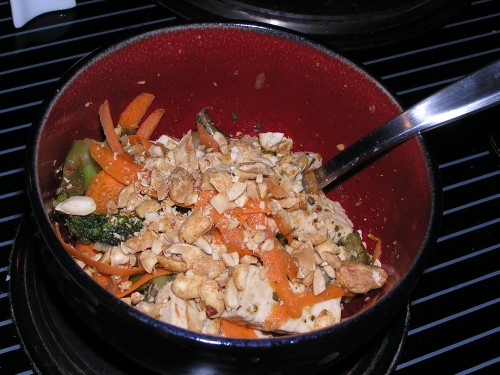
by Briscoe White | Jan 18, 2011 | Containers, Gardening, Growing, Herbs, Indoor Gardening, Miscellaneous, Recipes |
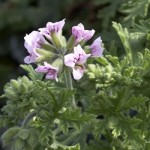
Citronella Scented Geranium
Long-loved for their intense fragrances that range from fruity and floral, to earthy and spicy, Scented Geraniums, or Pelargoniums are an amazingly aromatic ornamental and culinary herb. Cousin to the garden-variety red “grandma’s Geranium” seen so often growing in window boxes and flower beds across the South, Pelargoniums are in the same family and though they share the name, are not “true” Geraniums. First discovered in the 1600’s in South Africa, Pelargoniums were originally lumped in with Geraniums because of their resemblance and similar habit, but as their popularity rose and botany progressed, their taxonomy changed and they were given their own distinction. They received the name, Pelargonium to define them separately, which is derived from the Greek word for “stork”, as part of the bloom seems similar to a stork’s bill.
Reaching the height of their vogue in the Victorian Era, Scented Geraniums were cultivated in greenhouses throughout Europe for the herb’s numerous rich aromas, until fuel had to be reallocated to war efforts, which left enthusiasts unable to heat their greenhouses. With over two hundred varieties of this lovely, fragrant herb, it’s no surprise that they remain a favorite garden, patio and culinary herb for today’s gardeners. The biggest bonus of the Pelargonium is its intensely scented foliage. Depending on the variety, the leaves may be dainty and lacy, rounded or sharply defined, and come in many different verdant hues from light to dark green, including some species with cream or golden variegation on its fringes. Typically, the plant’s blooms have little to no smell, leaving the leaves with the bulk of the herb’s fragrance. Just as with their leaves, depending on the type of Pelargonium, blossoms may come in a variety of colors, patterns and shapes. Generally they all share the same five-petaled design, offering gardeners the option between pink, purple, white, red and yellow hues, masked centers, and wide or thin blooms. (Some even resembling miniature Orchids!)
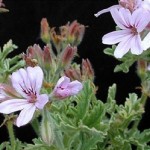
Rose Scented Geranium
In the kitchen, these herbs infuse desserts and other dishes with their scent, and delicately translate their perfumes to our taste buds. Pairing well with fruits like apples, melons and bananas, scents like Rose or Lemon really enhance the flavor of the meal. Try adding some of the Lemon or Peppermint leaves, wholly, to your next iced tea. You can also line the bottom of your cake pans when baking, with Scented Geranium leaves to infuse your favorite cake with a natural flavor. Also used to make syrups, jellies, liqueurs, and flavored butters, Scented Geraniums are a deliciously versatile herb.
Pelargoniums have also long been believed to possess magical and spiritual powers, usually dependent upon the scent or color. Thought to be a good luck charm for healthy, love, protection and powerful in repelling evil and negativity, Scented Geraniums were (and continue to be) used in bath infusions, perfumes, herb pillows and protective sachets. Though used solely in these functions for their fragrance in modern days, superstitions tied to specific scents still linger. It was once believed that Nutmeg Scented Geraniums would bring someone financial good fortune, while Rose Scented varieties would bring a healthy love life. Beliefs were also based on the color of the blooms, such as White Pelargoniums were a symbol of fertility, while Red strains meant strength and protection.
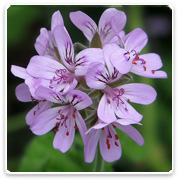
Atomic Snowflake Scented Geranium
Also used in arts and crafts like wreath and potpourri-making because of their long lasting fragrant leaves, Scented Geraniums are like nature’s little air fresheners! Fill your home with citrus and floral scents the natural way and stop using costly, chemical-based candles (plants won’t accidentally burn your house down!) and plug-ins. Lemon and Rose scents tend to grow ideally in containers and make great houseplants. Place them in a sunny window or in a high traffic area–brushing past the scented leaves will release each plant’s specific aroma and will revitalize your senses, especially after a long day. You can also place the leaves in your pillow case or dresser drawer. This will not only repel moths but perfume your laundry and soothe you as you sleep.
Three of our favorite varieties of Scented Geranium are the Citronella, Rose and new this year, the Atomic Snowflake! Each offers a distinct scent and beauty that performs well in the kitchen or garden and is ideal for container growing in or outdoors on patios and windowsills. We love making scented sugar for baking by alternating granulated sugar and Rose Pelargonium leaves, sealing the layers in a jar and leaving it in a sunny window for two weeks. This infuses the sugar with the delicate aroma of fresh cut roses and tastes delicious on cakes and cookies! If grown in high quantity, the Citronella variety is said to repel mosquitoes. Debated in the scientific and gardening communities as to its results, we love its citrusy smell—it reminds us of warm summer evenings. Last and certainly not least, our newest and one of the most beautiful breeds, is the Atomic Snowflake. The name alone brings excitement to mind and its hybrid scent of floral and fruity tones will make a great culinary garnish and a potent perfume for your home or garden!
by Briscoe White | Dec 8, 2010 | Herbs, Recipes |
Looking for a great appetizer to kick off your holiday meal? Try this great recipe we found on the Tortuga Rum Company’s website and give your family something to rave about with fresh Mojito Garlic Holiday Scallops! Not just great in drinks– who knew Mojito Mint could be so versatile? Give the gift of mint with our potted Mexican Chicken Pot, complete with Mojito Mint to spice up your holiday!
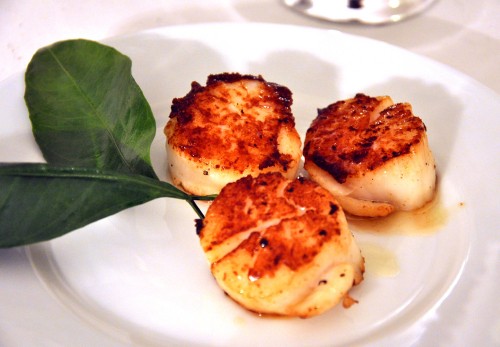
Mojito Garlic Holiday Scallops
* 20 Large Sea Scallops
*1/4 Cup of Butter
* 6 Minced Garlic Cloves (For a more subtle Garlic flavor, try our fresh Garlic Chives instead!)
* 4 Large, Chopped Scallions (Our fresh Chives can also be substituted for a less intense Onion taste)
*1/4 Cup of Light Rum
*1/4 Cup Finely Chopped fresh Mojito Mint leaves
* 3 Tbs. Key Lime Juice (or Fresh Lime Juice if Key Lime isn’t available)
* 1 Tso. Sugar
* 1 Tsp. Salt
* 1 Tsp. Ground Black Pepper
(For those of you who like it hot, try adding Red Pepper Flakes or a drizzle of hot sauce to kick things up a bit!)
1) Rinse the scallops in cool water and pat dry. Melt the butter in a large skillet over medium heat and saute` the garlic and scallions for about two minutes.
2) Once lightly brown, add the scallops and saute` for three minutes, then flip and cook another three minutes on the other side. Once tender, move the scallops to a plate and cover while you prepare the glaze.
3) Over medium to high heat (depending on your stove), combine rum, fresh Mojito Mint, lime juice, sugar, salt and pepper and stir until it begins to boil. Continue to stir for another three minutes, or until the sauce begins to thicken.
4) Stir in scallops gently and turn the heat off. Make sure the scallops are each covered in the glaze.
For a holiday garnish, use some of the fresh Mint leaves and place some Pineapple Sage or Bergamot to add a great green and red accent!
This is a great dish to serve by itself as an hors d’oeurve or you can make it a main course by serving it on a bed of rice, pasta, cous cous or salad! ¡Buen Provecho!
by Briscoe White | Dec 6, 2010 | Herbs, Life on the Farm, Recipes |
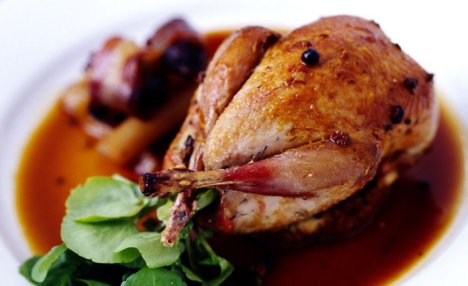
On the First Day of Christmas, if your true love gives you a partridge in a pear tree here’s how you can prepare it! Using a variety of our fresh herbs here’s a modern twist on a traditional dish that has become one of our favorites!
Roasted Partridge with Pear Salad
Serves 2
* 2 Partridges
* 5 Celery Stalks
* Sea Salt
Soak
* 4 Cups of Hot Water
* 1 Fresh Bay Leaf
* 1 Tsp. of Fresh Thyme
* 1 Sprig of Fresh Rosemary
*5 Chopped Fresh Garden Sage Leaves
* 1/4 Cup of Sea Salt
* 1 Lemon or Lime for Juice and Zest
Sauce
* 2 Tbs. Unsalted Butter
* 3 Tbs. Demi-Glace (store bought, or use our Bouquet Garni Kit to grow and make your own!)
* 3 Tbs. Apple Brandy
* 1 Tbs. Cider Vinegar
* 1 Minced Shallots or Chives
* 1/4 Tsp. Cinnamon
* Sea Salt to taste
1) Combine ingredients for soak with 4 cups of hot water. Stir and let cool to room temperature.
2) Once cooled, submerged partridges in soak mixture and refrigerate overnight.
3) Once refrigerated, preheat oven to 425 F degrees and pat partridges dry. Let sit and warm to room temperature for 25 minutes.
4) Stick 1/4 of a lemon or lime (or for a less acidic flavor, try using fresh Lemon Verbena) into each of the partridges. For a saltier taste, add a pinch of salt to each bird, otherwise the soak will have made them somewhat salty.
5) In an oven-proof pan, make a bed of the celery stalks in the bottom of the pan to lay the partridges on top for roasting. Oven roast for 35 minutes. Make sure meat in the center of the bird is around 155 with a meat thermometer to avoid illness.
6) Remove the celery and partridges from the pan and melt butter over medium heat. Saute shallots until slightly brown and add the ingredients to make the sauce. Stir well to combine each ingredient and let simmer until well cooked through, before turning off the heat completely.
Pear Salad
Serves 2
* 2 Asian Pears
*1 1/2 Cup of Walnuts (You can also used candied walnuts)
* 1 Cup of Goat Cheese
* Arugula, add more or less to your liking.
1) Wash and shake Arugula dry and add to bowls.
2) Dice pears and sprinkle over Arugula.
3) Add walnuts and goat cheese to your liking.











